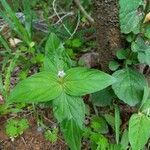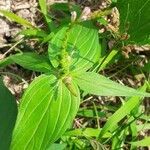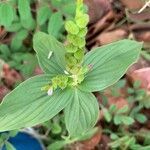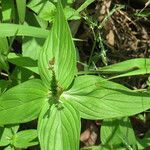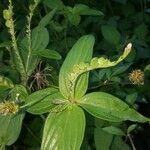Herb, annual, 15 cm-1.3 m high, the roots usually shallow and fibrous; stems ascending, leafless below the apical leaf whorl (the apical whorl actually consists of 2 decussate and sometimes unequal leaf-pairs not separated by a manifest inter-nodal area) or with 1-2 cauline leaf-pairs reduced in size with respect to the apical whorl, simple or few-branched, glabrous or puberulent on the extreme distal por-tion with simple trichomes 0.1 mm long or less, becoming ? terete and suffrutescent at the base; branches and at least the distal 1/2 of the main stem compressed, green, weak, subsucculent, often faintly striolate. Leaves sessile or with petioles to 10(-20) mm long, the leaves of the terminal whorl often sessile or subsessile; blades 2-18 cm long, 0.8-6.5 cm broad, broadly ovate or rhombic-ovate to lance-oblong or lance-elliptic or lanceolate, apically acuminate or acute, basally acute to broadly rounded or sometimes approaching subtruncate, often decurrent long the petiole, paler green below, membranous, marginally usually ciliate with simple mammil-late trichomes 0.1 mm long or less, glabrous above or with minute scattered mam-millate trichomes, glabrous below or minutely puberulent along the main veins, the midvein and secondaries apparent on both surfaces, sometimes slightly raised below, the 6-14 secondaries arising pinnately from the midvein and arcuate-ascend-ing, the reticulation typically faint or obscure on both surfaces; stipules broadly deltoid, 1-3 mm long. Spikes 1-5, simple or infrequently branched, 3-18 cm long, 10 to 40-flowered, terminal but sometimes overtopped by floriferous branches. Flowers closely aggregated at the tip of the spike, soon separated by 2-7(-15) mm by internodal elongation, the pedicels obsolete to 1 mm long; calyx-lobes free to the base, linear-lanceolate, often dialated at the base, 2-6.5 mm long, unequal or subequal, minutely ciliate marginally and externally along the keeled midrib but otherwise glabrous; corolla rather narrowly funnelform or tubular-funnelform, white to pink or lavender, glabrous, soon fugaceous, the tube 6-16 mm long, 2-4.5 mm broad at the throat, 0.7-1.5 mm broad at the base, the lobes ovate-deltoid or virtually rhombic, 2-3 mm long; anthers included, 0.8-1.5 mm long, the free-portion of filaments ca 2 mm long, attached to corolla-tube somewhat above the middle; ovary ca 0.8 mm long, subglobose, the style extending to the opening of the corolla-throat, with the upper 1,2 (or slightly less) swollen and eventually deciduous, the stigmatic region pubescent. Capsules ca 4 mm long, 5-6 mm broad, compressed at right angles to the septum, conspicuously muricate except at the base, the persistent cupular base navicular, pointed at the ends; seeds brownish, ovoid to suborbicular, 1.5-2 mm long, carnose, externally conspicuously tuberculate.
More
Annual herb, 2-25(-70) cm high, unbranched or with some pairs of strong branches near the base; stems erect, terete, glabrous, with a few remote pairs of rather small leaves and an apical pseudo-whorl of 4 larger ones. Leaves connected by interpetiolar, broadly triangular, blunt, glabrous stipules, ovate-oblong to ovate-lanceolate, 3-10 by 0.75-5 cm, herbaceous, scabrous above, glabrous beneath, cuneate and often decurrent at the base, attenuate at the apex; nerves 4-5 pairs, strongly ascending; petiole 0-1 cm. Inflorescences terminal and usually in the axils of the whorled upper leaves, up to 15 cm long, peduncle very short, glabrous or nearly so; bracts lanceolate, 2-3 mm long. Flowers spaced, (sub)sessile. Sepals free, quincuncial in bud, somewhat unequal in length, ovate-linear-lanceolate, 2-3.5 mm, acute, glabrous or outside sparsely puberulous, pale green. Corolla salver-shaped, glabrous, white to red or purplish; tube 6½-15 mm, lobes exduplicative-valvate in bud, triangular, 2-2½ mm long.Stamens glabrous, inserted slightly below the middle of the tube, filaments filiform, ± 1 mm, anthers attached slightly above the base, lanceolate, 1.25-1.75 mm, obtuse. Ovary glabrous, subglobose, 0.5-0.75 mm ø, style cylindrical, 0.75 mm; stigma ovate-lanceolate, 2 mm, pubescent near the tip, caducous. Capsule 4-5 by 5-6 mm, squamulate-tuberculate mainly in the upper half. Seeds obliquely ellipsoid or ovoid, 2-3 by 1½-2 mm, dull brown, tuberculate.
An annual herb. The leaves are opposite and clasp the stem. The upper ones often form a ring. They are 3-12 cm long by 1-5 cm wide. They are oval to sword shaped.
A weed of sandy seashores, river-banks, fields, gardens, roadsides, waste places, from the beach up to 600 m; locally often common, but on the whole rather rare. A self-pollinating plant; the flowers are open from 2-5 in the afternoon. Fl. fr. Jan.-Dec.
More
Damp thickets at elevations below 500 metres in Guatemala. Along roadsides, in waste places, arable land, gardens, rice fields and on riverbanks, at elevations from sea-level up to 600 metres in Africa.
Common weed of waste places.
Can be grown by seedlings. Seeds needs stratification.
